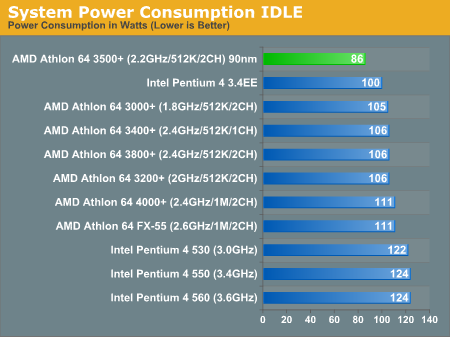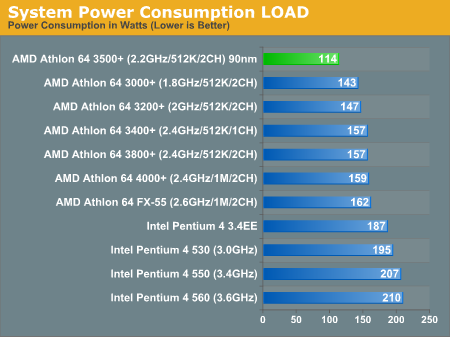AMD Athlon 64 4000+ & FX-55: A Thorough Investigation
by Anand Lal Shimpi on October 19, 2004 1:04 AM EST- Posted in
- CPUs
Power Consumption
To measure power consumption we looked at overall system power consumption and tried to keep as many variables static. There are some basic differences which we cannot get around, mainly that the 925X uses lower voltage DDR-II while the nForce4 uses regular DDR, but for the most part our results were quite controlled. We also included power consumption figures from 130nm Socket-939 Athlon 64 3200+ and 3000+ chips, which as you may know, do not exist. The reason we did this was to show the sharp contrast to the power consumption figures of the 90nm 3500+ we've included in the charts below.
We measured power consumption in two states: idle sitting at the Windows desktop and under load while running our Windows Media Encoder 9 test, which proved to be one of the most strenuous CPU tests we ran as it pretty much isolated the CPU subsystem.
At idle, the 130nm Athlon 64s all consume just about the same amount of power, with the 90nm Pentium 4s doing a little more. But what's truly impressive is the 90nm Athlon 64 3500+, drawing less power than any of the other chips at idle - by a significant margin.

Under load the situation is no different; because of the fact that AMD didn't change anything architecturally (nothing major at least) with the 90nm shrink, the Athlon 64 got what the Pentium 4 should have received with the move down to 90nm - much lower power consumption. However, tack on 32-bit ALUs (as opposed to the 16-bit ALUs in the Northwood Pentium 4), a much longer and more power hungry pipeline as well as logic to support it, and you're looking at a much more power hungry chip. The 90nm Athlon 64 does not suffer this same fate and thus is almost a lower power chip compared to the competition here.











89 Comments
View All Comments
coolme - Monday, January 10, 2005 - link
#85 yeah, but when comparing to Tom's Hardware review, it's totally off track... (Tom's is more believeble because there is pics of how he measured it and based on the fact that there is no way a A64 could handle 200+ watts)http://www6.tomshardware.com/cpu/20041115/pentium4...
how Tom tested it: http://www6.tomshardware.com/cpu/20041115/pentium4...
eight - Monday, December 27, 2004 - link
Has anyone information about A64 performance with Premiere Pro 1.5? I assume thet A64 does beat P4, but assumption is mother of... :)euanw - Tuesday, November 9, 2004 - link
#44Wesley,
I am very impressed by your articles. Can you inform me of the procedure you used to overclock the FX55? With the Neo2 board I am not clear on CPU vid and CPU voltage, what do they mean? When I change the multiplier to 13.5 my new PC reaches winXP and then reboots.
My setup is MSI K8N-Neo2-54G, FX-55, 2 x 512MB - OCZ EL DDR PC-3200 Platinum Rev2, Nvidia Quadro FX3000, 2x Seagate Barracuda 7200.7 120 GB, Matrox RTX-100 real time video editor, Antec TrueBlue 480W ATX-12V, BenQ DVD Dual DW1610, WinXP-SP2.
euanw - Tuesday, November 9, 2004 - link
#44Wesley,
Gioron - Sunday, October 24, 2004 - link
While I'm unsure of the exact method used in this review, I'm sure that there is no built-in power measurement devices on the motherboards and processors listed (unless its new and no one told me...) so its NOT just just a matter of installing software that can read a sensor thats already there (as in all the CPU temp monitors). This means it requires some hardware to measure the voltage and current flow to various components (or you can cheat a little and assume the voltage is constant and just measure current).Unfortunately, this is not as easy as it sounds, since isolating various components can be a problem. Its fairly easy to measure things like hard drive power useage since there is only one power connector going to it and its easy to access, so you measure the current on the 5v line and the current on the 12v line, and you're pretty much done. Things like CPUs, motherboards and graphics cards are a bit more difficult. On the newer graphics cards you can measure the power consumption from the additional molex connector, but in all likelyhood, the card will also draw a certain amount of power from the AGP slot power lines, and no one in their right mind is going to unsolder the AGP slot and raise it half an inch in an attempt to put a current sensor in line with the power leads. Thus, you need to rely on indirect means and educated guesses. You can measure the current going into the motherboard, but how much of that is going to the chipset, the CPU, the RAM and the graphics card? You can swap in a different CPU and see how it changes, but that won't give you absolute readings. You can try to remove the CPU and see what power the MB uses without one, but odds are it'll use more power when its actually interfacing with a CPU instead of beeping error codes at you.
Bottom line: There is no easy way to measure power consumption, and even dedicated hardware review sites have problems with it. Personally, I trust Anand far enough that I'm sure he didn't completely screw it up, and the numbers he has are probably close enough to the real thing. I'd forget about measuring power for myself.
xsilver - Friday, October 22, 2004 - link
Kinda late on the comments but..If anand or anybody can answer -- what is used to measure the "power consumption" software? or hardware? links? I would like to test this myselfthanks
Bakwetu - Friday, October 22, 2004 - link
Whoah, it's been a while since I checked out cpu reviews and I must say Amd has some impressive cpu:s nowadays. Even though I am budget oriented when it comes to buying hardare, I'd choose the 3400+ model before the 3200+, it's not all that much more expensive and seems to perform much bettert - Friday, October 22, 2004 - link
79uhuh.... and in a server type situation, how many raid arrays are ran off the chipset controllers? not many i would wager..
hell... u prolly have an independent fibre optic raid array :)
hardware, baby, hardware.
t.
knitecrow - Friday, October 22, 2004 - link
I always knew women were trouble when it comes to technology ;)screech - Thursday, October 21, 2004 - link
nice ones #79, 78. :)